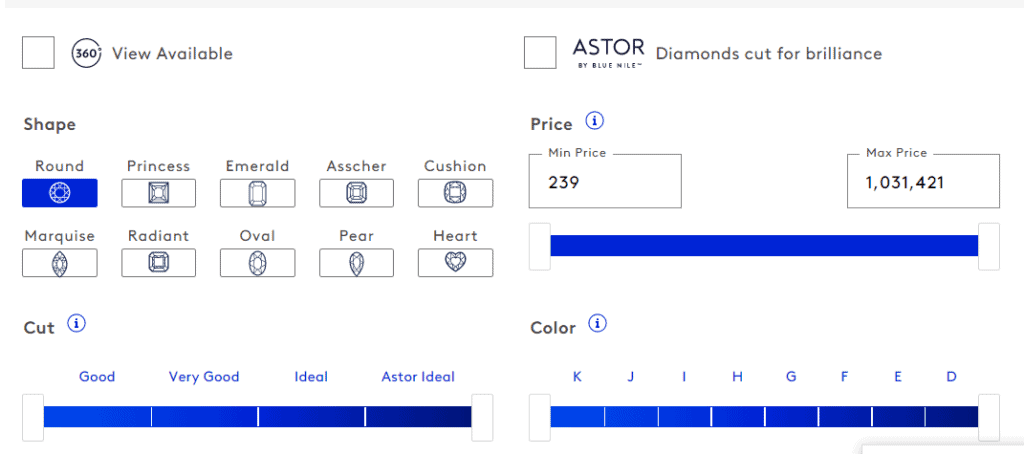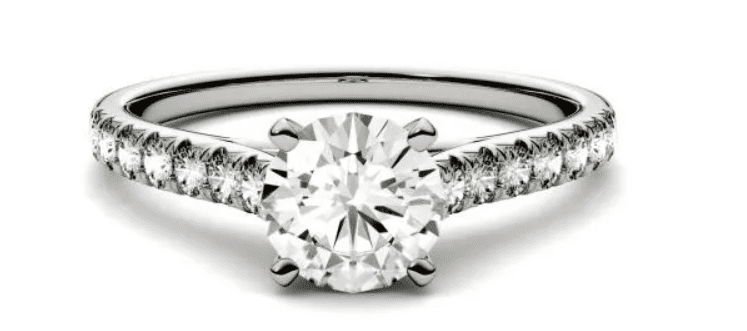For many, imagining the best engagement ring means a large, brilliant-cut diamond. But knowing how to find the best ring for your budget and style isn’t so simple. And now more than ever, it’s important to be open to different definitions of what makes the “perfect” engagement ring.
And while classic and high fashion diamond engagement rings are still popular, Americans are looking for unique ways to express their love. One of the most noteworthy examples? Pokemon Engagement Rings are stealing hearts in the gaming world– and some side glances outside it.
For the 25th anniversary of Pokemon, the unique engagement ring collection crafted by UTreasure features different styles, all with a Pokemon theme. The one that’s grabbing headlines is a solitaire diamond ring set in 18K gold. The center diamond is 1.032 carats and features Pikachus on either side.
Also, in the collection? Mew, Espeon, and Umbreon. And all engagement rings come in a Master Ball presentation box. They aren’t cheap either– these rings cost as much as $10,000 each.
The point is, whether you love the idea, find it interesting, or cast it off as tacky, the idea of the perfect engagement ring is being debunked, and more are opting for ways to express their love that doesn’t always fall into tight rules.
In this guide, I’ll tell you how to select the best engagement ring for your partner– from how much you should spend to every feature that goes into selecting a ring.
How Much Do you Spend on an Engagement Ring?

The classic question is how much to spend on an engagement ring. And while you’ll see conventional advice to 2 to 3 months’ salary on an engagement ring, many are rejecting that rule– and for a good reason. The advice may seem like it’s trying to keep budgets in mind when truthfully, it’s an arbitrary guideline that was first promoted– and continues to be–by jewelers.
A better way to look at it is that 2 to 3 months’ salary may be wise to set as a maximum amount you spend. Consider that the average salary in the United States is around $52K. The conventional advice would be to spend an average of $8,000 to $13,000.
How much does the average person spend on an engagement ring?
In reality, the average American spends only $3,700 on an engagement ring, according to a 2020 Brides’ American Wedding Study.
Even averages can be deceiving. For instance, outliers– those who spend over $10K on a ring– can make the average cost of an engagement ring artificially high. But what it does show you is that you can buy a great engagement ring for less than you think. Think about other expenses– including a future wedding– and only spend what you can comfortably pay off right away or within a few months.
Can you get an engagement ring for $1000?
$1,000 is a modest amount to spend on an engagement ring, but by no means is it impossible. You’d need to choose either a lab-grown diamond or a diamond alternative, such as moissanite or a colored gemstone. You’ll need to opt for a modest carat size– such as ⅛ to ⅓ carat– and a more affordable metal, such as 10K or perhaps 14K gold. While challenging, rest assured there are ways to buy an engagement ring on a tight budget.
Is $5,000 good for an engagement ring?
$5,000 is a pretty healthy budget for an engagement ring. At this price– and even a price range from $2,500 to $5,000 you can buy an engagement ring of excellent quality. You may not be able to have the largest carat size– think 1 carat or less- but this budget is the average budget for most Americans, and you’ll also open up your options for different styles and metal types.
Is $10,000 a lot for an engagement ring?
$10,000 is more than enough for an impressive engagement ring. At this price, you can afford a diamond ring that’s up to 1.75 carats, give or take. You can also opt for platinum or 18K gold. A $10K budget gives the flexibility to shop where you want.
Which Metal is Best for an Engagement Ring?

The metal you select for an engagement ring plays a role not only in the beauty of the ring but, more importantly, its durability. The most common metal types for engagement rings include 925 sterling silver, 10K gold, 14K gold, 18K gold, gold plating, and platinum.
Should engagement rings be silver or gold?
Silver is a traditional choice, but I recommend against buying even the finest quality silver for an engagement ring. 925 sterling silver will save you money at first, and it’s a beautiful metal. The problem is that it’s prone to tarnish– not only from exposure to water but everyday chemicals. Pure silver is more valuable but a worse choice, as it’s an exceptionally soft metal and can easily be scratched or damaged.
Which is better: 10k or 14K gold?
10K gold is a harder metal than 14K gold, but it’s also less valuable and has a dull appearance. 10K gold will save you money and may be suited for someone who wants to wear their ring heavily– but it’s missing that luster that 14K gold has.
Which is better: 14k or 18k gold?
Between 14K and 18K gold, the answer is not clear-cut. I think both are excellent choices and have merit. The general rule is that the greater the purity level, the more valuable, the higher the luster, and the softer the metal. Thus, 14K gold will save you a little money vs 18K gold and be less prone to scratches. 18K gold, meanwhile, has the benefit of a beautiful shine.
I’d recommend opting for no greater than 18K for a ring. 22K or 24K gold is beautiful, but for a ring that’ll be worn every day, these are both rather soft metals and can easily dent or scratch with everyday wear.
Is platinum worth it for engagement rings?
Platinum is an excellent choice for engagement rings– but it’s also pricey. Platinum won’t tarnish, is very difficult to dent or scratch, and won’t corrode. It’s one of the most durable metal types you can select and has a high shine. You do have to expect you’ll end up paying more, and for some, 14K or 18K gold rings are just fine. In other words: if you have the extra money, platinum is an excellent choice and worth the cost–, but it isn’t necessary or the best fit for everyone.
What Carat Size Should I Get?
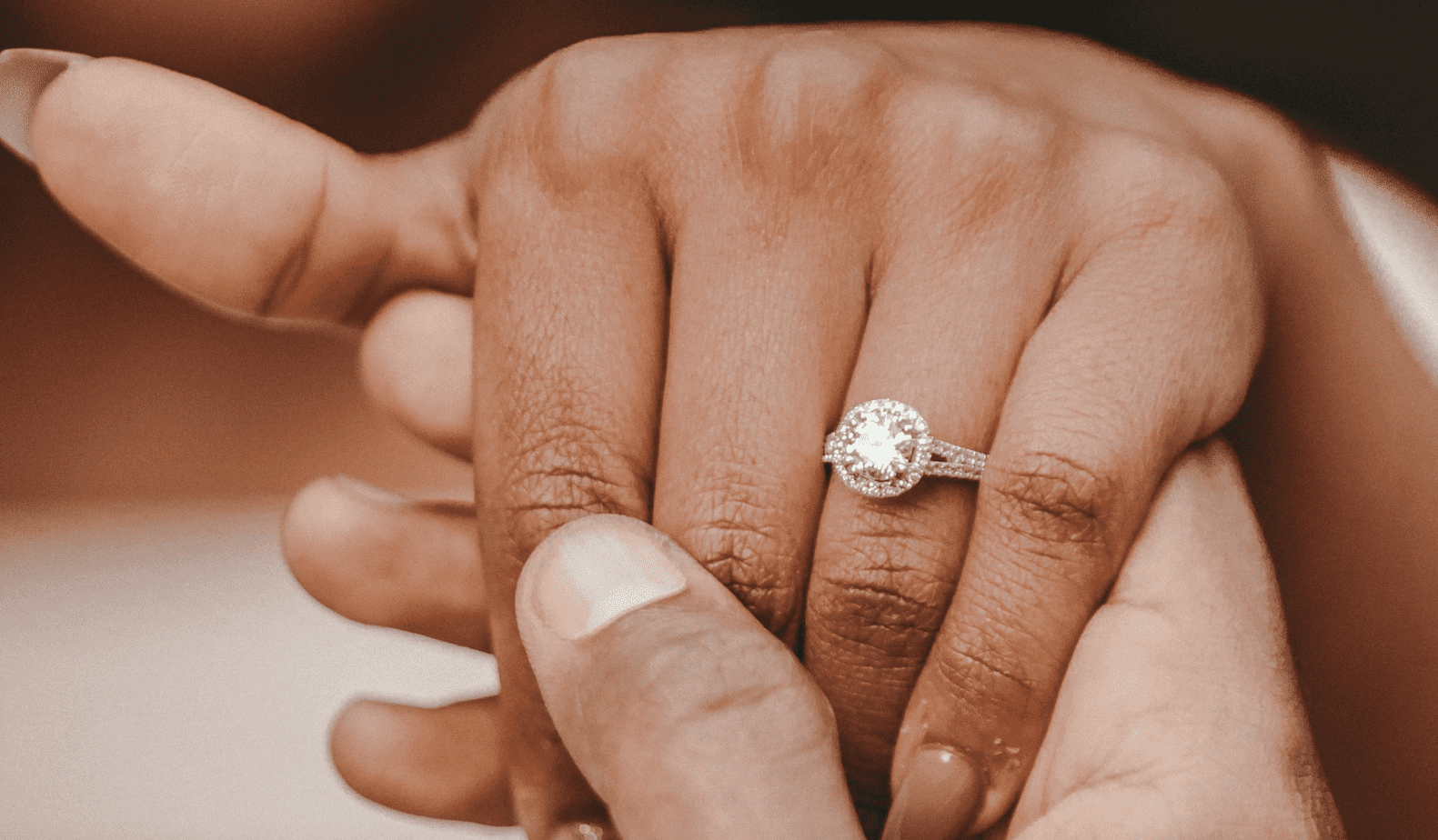
Carat size is often the biggest topic when it comes to finding the perfect engagement ring. In truth, I recommend you choose carat size only after you’ve considered cut, clarity, and color. The reason? The greater the carat, the more noticeable the diamond quality will be. Thus, it’s better to buy a diamond with an excellent color and clarity rating with a smaller carat size.
After establishing how much you’ll spend on your ring, take a look at the diamond color and clarity that’s acceptable to you. You can then determine carat size by looking at what’s in your price range. It may also be helpful to look at how many carats the average engagement ring is, as well as popular perceptions about carat size.
How many carats is the average engagement ring?
According to Brides.com, the average size of an engagement ring in the United States is 1 carat, and 0.6 carats in the United Kingdom. Keep in mind that averages can include outliers– meaning that this could also include those with 10-carat rings, for instance. The point is, 1 carat is considered a decent size, and even 0.5 carat is not considered small.
Is a .5 carat diamond too small?
There’s a misconception that a .5 carat diamond is too small for an engagement ring– and this is by no means true. At a half-carat, the diamond is still visible and is a more subtle engagement ring. It’s a very popular size–proving you don’t need a large carat size for a beautiful engagement ring.
Is a 2-carat engagement ring impressive?
It depends on your definition of impressive, but given that the average diamond engagement ring is half that size, a 2-carat ring is considered large. This is a size suited for a show-stopping ring while not being so large that it is not practical for the average person.
What is the Best Cut for an Engagement Ring?
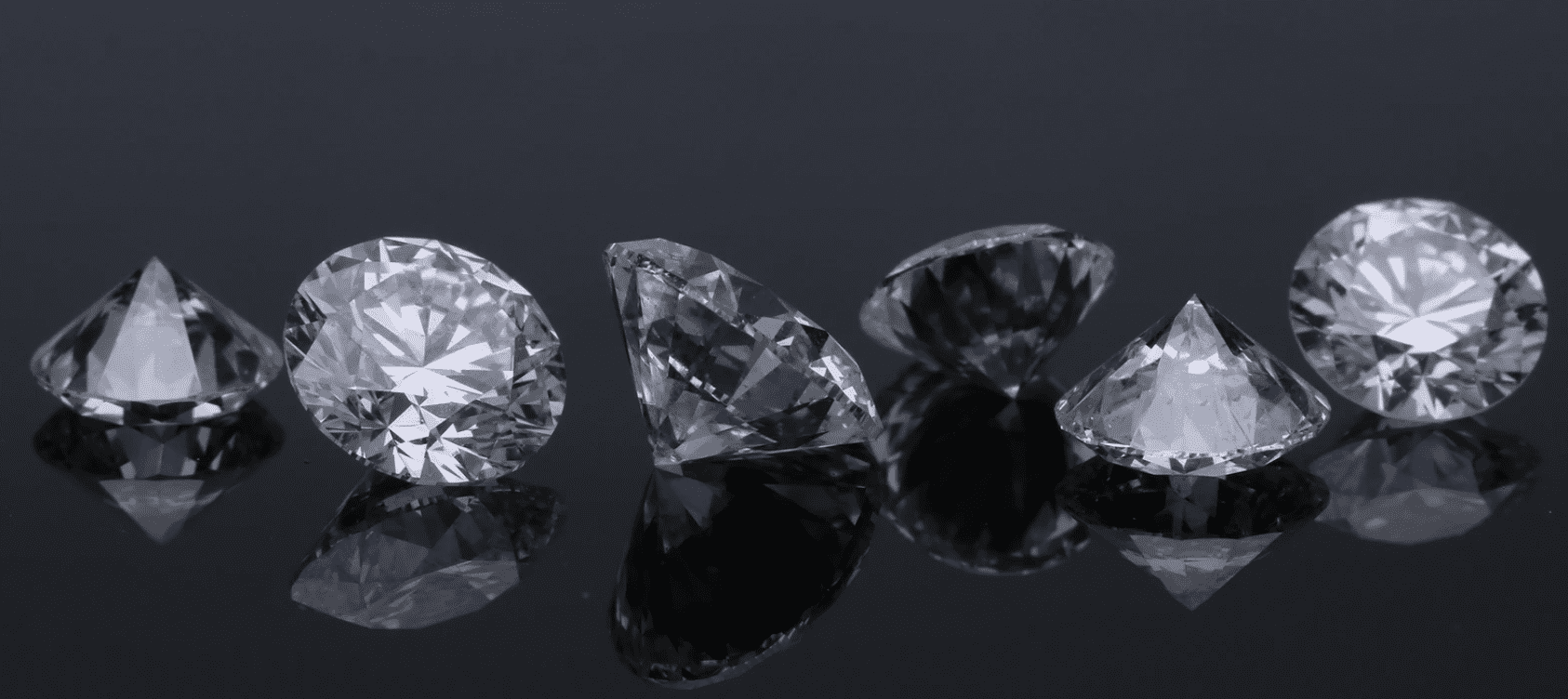
Cut affects the way light reflects– and can also affect sparkle. Poor quality cuts can reduce that signature sparkle, but there’s a little more wiggle room in terms of what to select. The most important thing you can do is to ensure that you’re buying from a respected jeweler so that no matter the type of cut, you can ensure that it’s done properly to optimize fire and brilliance.
| Diamond-Cut | Description | Pros | Cons |
| Asscher Cut | Elongated facets and asymmetrical cut are the identifying features of this cut, first popularized during the Art Deco era of the 1920s. |
|
|
| Cushion-Cut | This popular cut originated during the 1800s and is known as a great alternative to a round brilliant cut, with a shape like a cushion. |
|
|
| Emerald-Cut | Designed originally for emerald, the elongated shape is compared to Asscher cuts but is more square. |
|
|
| Heart Cut | As the name suggests, this is a heart shape for a romantic appeal. |
|
|
| Marquise-Cut | Marquise cut has vintage appeal for a reason. This shape was famously worn in the court of Louis XV and has remained a classic ever since. |
|
|
| Pear-Cut | Pear cuts are, of course, shaped like a pear. It’s also one of the oldest cuts, with some experts citing it as far as back as the 1400s. |
|
|
| Princess-Cut | Like the cushion cut, the princess cut is one of the most popular, aside from round brilliant. The princess cut can be square and occasionally rectangular. |
|
|
| Radiant Cut | The name should clue you in. A radiant cut is one of the most popular options for a brilliant diamond. Popularized first in the 70s, it features a square shape with a deeper cut. |
|
|
| Round Brilliant Cut | The round brilliant cut takes the top spot for the most popular diamond cut, accounting for 60 percent of diamonds. |
|
|
| Oval-Cut | An alternative to a round-cut, oval cuts are more elongated but offer some of the appeals of a round cut at a lower price. |
|
|
What is the most beautiful diamond cut?
The most beautiful, expensive, and popular cut for a diamond is a round brilliant diamond. The cut optimizes sparkle and brilliance. The GIA reports that round brilliant diamonds make up around 60 percent of engagement ring sales, too. If you have extra money to spend and you care most about brilliance, this is the ideal cut for your diamond engagement ring.
What is the cheapest cut of diamonds?
Both Asscher and Emerald cuts are the most affordable- but by no means does this mean that they’re a poor choice. They’re less popular than other cuts, with more rectangular shapes. To select the best cut for you, you should balance style and price. See the chart above for the pros and cons of different diamond cuts. Asscher and emerald cuts have a unique beauty, but as brilliant as other cuts, like round brilliant and radiant diamonds.
What Diamond Color and Clarity is Best?
Arguably even more important than the cut is the diamond’s color and clarity. Color and clarity impact beauty and brilliance. Knowing what to select and avoid is key– and it isn’t all about just buying the very best, but knowing what quality to avoid dipping under.
What is the best color in a diamond?
Except for rare fancy colors, colorless diamonds are always the most valuable and ideal. The lower you go in terms of diamond color rating, the more of a yellowish tint you’ll encounter. You should opt for a colorless or nearly colorless diamond. Anything below this quality will be noticeably yellow and mar the beauty of the diamond ring. Diamond color is rated from D to Z by the GIA, with D being colorless and Z a deep yellow or even brown. The chart above is from the GIA and shows what diamonds at different color ratings look like. I’d opt for a diamond rated D to me.
What does diamond clarity mean?
Diamond clarity refers to the inclusions or imperfections. At the worst, you can see visible inclusions with the naked eye. But even inclusions that aren’t visible to the naked eye impact how light passes through– thus, reducing brilliance.
Which clarity is the best for diamonds?
Clarity is rated from flawless to included. Flawless diamonds are nearly unheard of, as they are internally flawless. Very very slightly included (VVS1 and VVS2) are the next ideal, followed by very slightly included (VS1, VS2) and slightly included (Sl1 and Sl2). I would not go below slightly included. If you have a larger carat size (above 1 carat), you should aim for very slightly included at the least, and potentially very, very slightly included. In my opinion, you may not notice enough of a difference to hunt for and spend on a flawless diamond.
Which is better: clarity or color?
Clarity and color both affect sparkle. Thus, think of them as working together. However, I would prioritize color first, clarity, second cut third, and then carat size. Some flaws may not be immediately noticeable, but a diamond with a yellowish tint is immediately noticeable to the naked eye.
What’s the Difference Between Lab-grown and Real Diamonds?
| Type of Diamond | Pros | Cons |
| Natural |
|
|
| Lab-Grown |
|
|
| Simulants (Cubic Zirconia) |
|
|
Lab-grown diamonds are real diamonds. One of the worst mistakes you can make is mistaking simulants vs lab-grown diamonds. Lab-grown diamonds can be an alternative to natural diamonds and are sold widely by many fine jewelers.
What does simulated mean for a diamond?
A simulated diamond is not a real diamond. The most common stimulant is cubic zirconia. This low-cost gemstone has a similar clear appearance but a noticeable shallowness to its brilliance. Cubic zirconia is not as durable– or precious– as a diamond and is marked by its rainbow scintillation. The greater the carat of cubic zirconia, the more noticeable the difference between CZ and a diamond is. A cheap price is a tell-tale sign and terms like “lab-created” (as opposed to lab-grown).
Are lab-grown diamonds cheaper than natural?
Lab-grown diamonds are cheaper and less valuable than natural diamonds. They are physically identical and share the same chemical properties and physical properties. This lab-grown diamond is as durable and immediately beautiful as a natural diamond– it’s simply less valuable.
Do lab-grown diamonds have resale value?
As lab-grown diamonds have gained in popularity, their value has as well. Left in great condition, lab-grown diamonds hold their value.
Why are natural diamonds better?
Natural diamonds are more expensive and, of course, more valuable. This value is only made more apparent the longer you own a natural diamond. While lab-grown diamonds retain their value, natural diamonds exceed their initial value. That said, there is no difference in terms of durability or beauty. If you decide on a natural diamond, pay attention to diamond sourcing.
Can diamonds be conflict-free?
Lab-grown diamonds are conflict-free, but natural diamonds can be as well. The Kimberley Act defines conflict-free diamonds ensure that diamonds are not mined to finance civil wars or violence. Beyond Conflict Free, defined differently depending on the company, goes further to ensure practices such as fair labor and sustainability.
Can Engagement Rings be Other Than Diamonds?
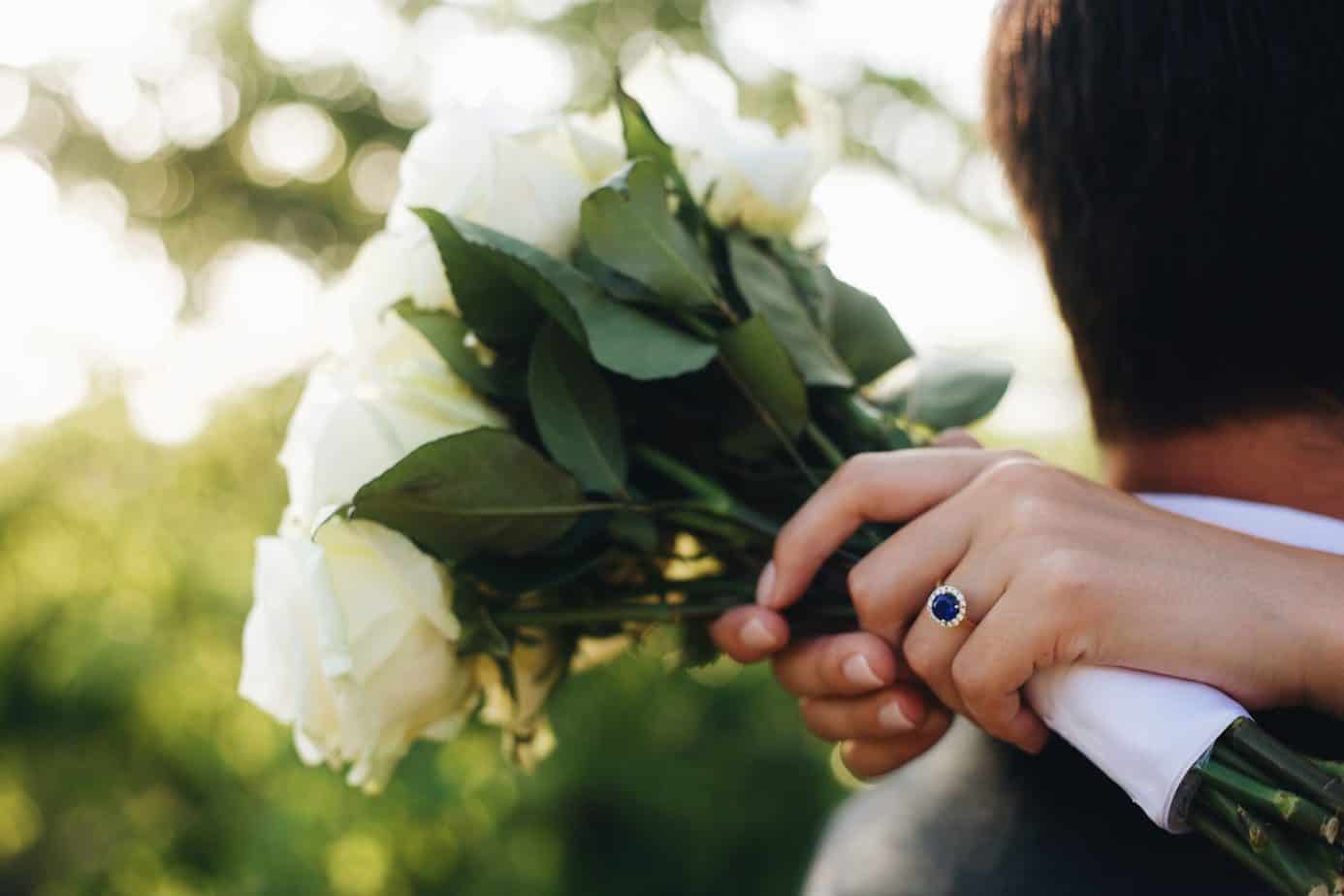
According to 2019 data reported by The National Jeweler, diamond engagement rings make up 85 to 90 percent of all engagement rings sold in the United States. Of course, while most couples will buy a diamond engagement ring, that isn’t your only option. An alternative usually will save you money, and in some cases, it will make your ring stand out. No rule says you have to have a diamond for an engagement ring. Keep in mind what your partner would most like, and don’t be afraid to go slightly less conventional.
What is a good alternative to a diamond?
| Gemstone | Description | Pros | Cons |
| Forever Moissanite | Forever Moissanite is high-quality, clear moissanite. It’s colorless and features double refraction, making it amongst the most brilliant gemstones.
Mohs Hardness: 9.25 |
|
|
| Ruby | From deep pink to deep red, rubies are a majestic gemstone and even more valuable than diamonds. Vivid red colors are the most prized.
Mohs Hardness: 9 |
|
|
| Sapphire | Most known for deep blue, sapphire can be many colors, as varied as pink, orange, yellow, green, purple, and violet. Deep blues to blues with purple undertones are considered the most desirable.
Mohs Hardness: 9 |
|
|
| Emerald | Likely this gemstone needs no introduction. Emeralds can range with yellow and blue undertones. The most prized emeralds are a bold green, with slightly cool, blue undertones. Vivid colors are more desirable than darker hues.
Mohs Hardness: 7.5 to 8 |
|
|
Finding a great alternative for a diamond engagement ring takes careful consideration. The best alternatives are durable and have some level of brilliance. If you’re looking for an alternative that’s almost like a diamond, moissanite is your best bet. If you’d rather go more colorful, rubies and sapphires are your best option. Some opt for emeralds, though this is a softer stone and must be handled with care. See the chart above for a comparison of the best diamond alternatives.
How are Gemstones Rated?
Natural, Colored Gemstone Gradings
| Grade | Description |
| AAAA | Top 10 percent. High levels of brilliance and few inclusions. |
| AAA | Top 20 to 30 percent. Moderately high levels of brilliance and some inclusions. |
| AA | Top 50 to 75 percent. Lower brilliance and acceptable levels (but notable) inclusions. |
Like diamonds, gemstones are rated based on clarity, cut, color and carat. The biggest difference is in the color scale. Colored gemstones are graded based on hue, saturation, and tone. Hue describes the general color and undertones. Tone refers to how light or dark a gemstone is, and saturation refers to how intense that color is. The GIA includes the following: red, orange, yellow, green, blue, violet, and purple. The general rule is that the more vivid the gemstone, the more desirable it is. Darker tones tend to be less valuable.
See the chart above for letter grading, which is a common way jewelers make it easy for consumers to understand gemstone quality.
Where Do I Buy the Best Diamond Engagement Rings?
There are so many places that you can buy diamond engagement rings, and many are highly respected. The most popular stores are all owned by Signet Jewelers, a large parent company that owns Zales, Kay Jewelers, James Allen, and Jared. The good news is that these businesses all have decades of experience and offer fair prices. However, my top recommendations go a step further, offering a wider and more unique selection alongside high standards for ethical sourcing.
My Selection Criteria
My top two picks for places to buy diamond engagement rings online are held to high standards. Diamonds are ethically and sustainably sourced or lab-grown. All of these companies boast an A+ rating with the Better Business Bureau. You can create your rings or buy premade rings, and metal options are 14K or 18K gold, as well as platinum. Diamonds are cut with care, and rings are crafted with precision. While slightly more expensive than Signet, in my opinion, these companies go a step further for gorgeous diamond engagement rings.
Brilliant Earth Diamond Engagement Rings
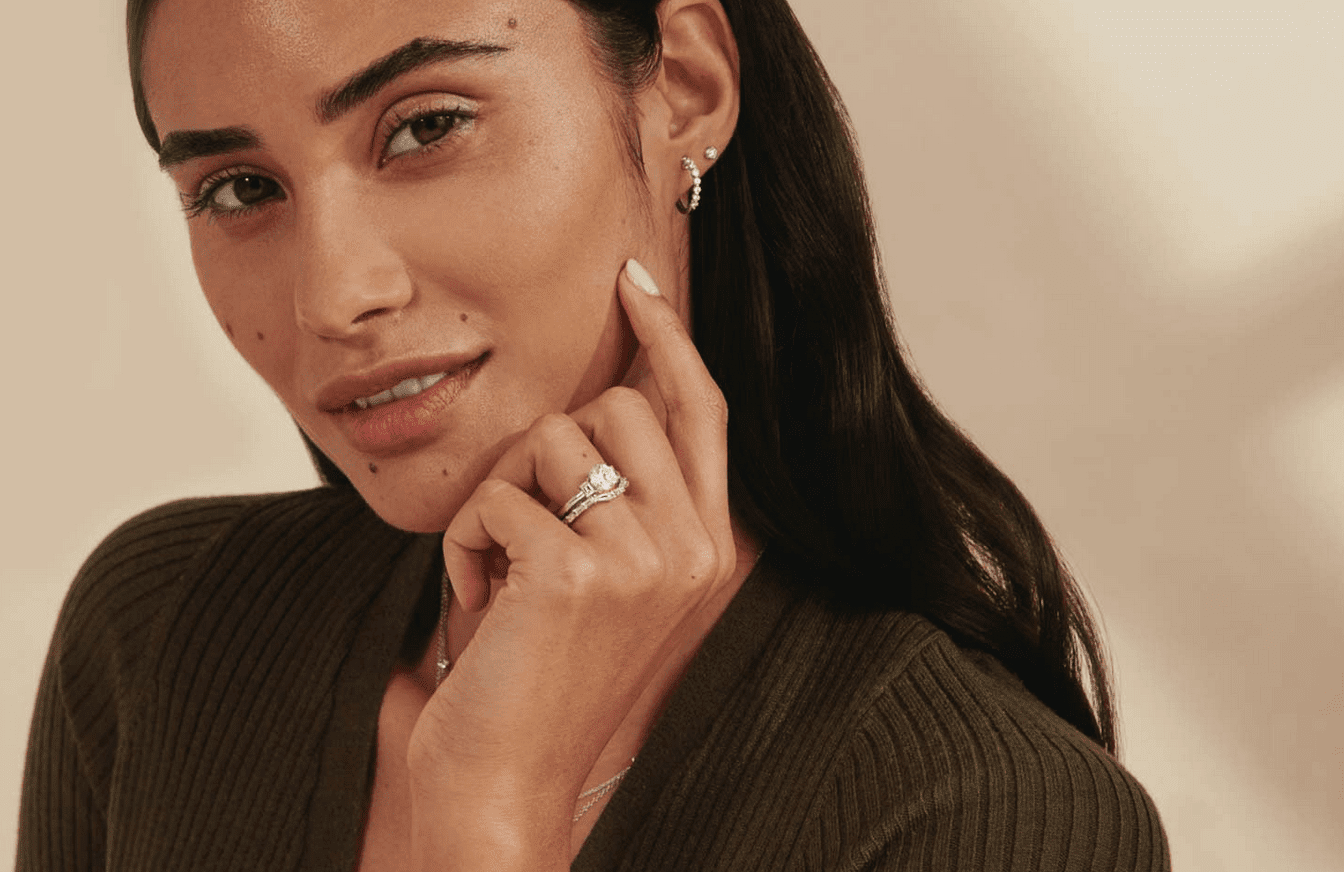
Brilliant Earth is the leader in ethically sourced diamonds– but also modern craftsmanship. With their “Beyond Conflict Free” model, rings are made with sustainably and ethically sourced gemstones, recycled precious metals, and some proceeds go towards supporting local communities. Main styles include vintage-inspired, modern classic, glamorous halo, three stone, and engagement rings with subtle accents.
You can Shop All Brilliant Earth Diamond Engagement Rings Here.
Create Your Diamond Engagement Ring

Create a truly unique diamond engagement ring with as many options as you could want. Start with a setting, from a petite twisted vine to an enchanting entwined Celtic knot and countless other classic and modern styles. You’ll have a choice of platinum or stunning 18K white, rose, or yellow gold for most settings.
You then select the diamond of your choice (all shapes imaginable and up to 7.28 carats). You can sort by lab-grown and natural diamonds, shape, carat, cut, color, and official diamond grading reports. As you design your ring, you’ll see transparent prices and be given a final chance to review your ring. Start Designing Here.
Versailles Diamond Engagement Ring

This exquisite ring is an example of their vintage-inspired designs. Marquise diamonds add allure to a sleek metal band, complemented with a sparkling round diamond. Crafted in your choice of 18K gold or platinum.
Four-Prong Petite Comfort Fit Engagement Ring
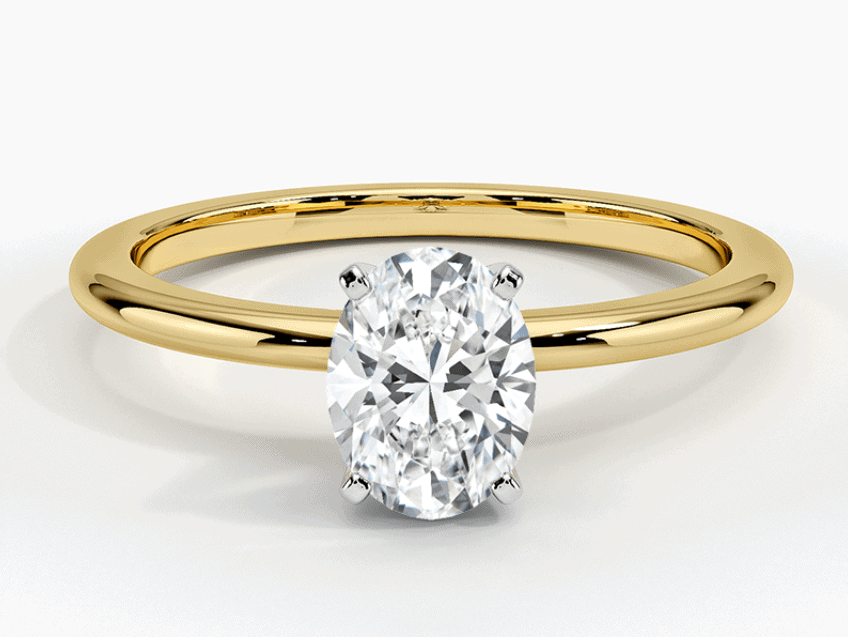
A four-prong setting is timeless and versatile. If you want to showcase the beauty of a center diamond, this may be the way to go. The band is designed for a comfortable fit, making it an easy favorite. Available in 18K white, yellow, or rose gold.
Waverly Diamond Engagement Ring
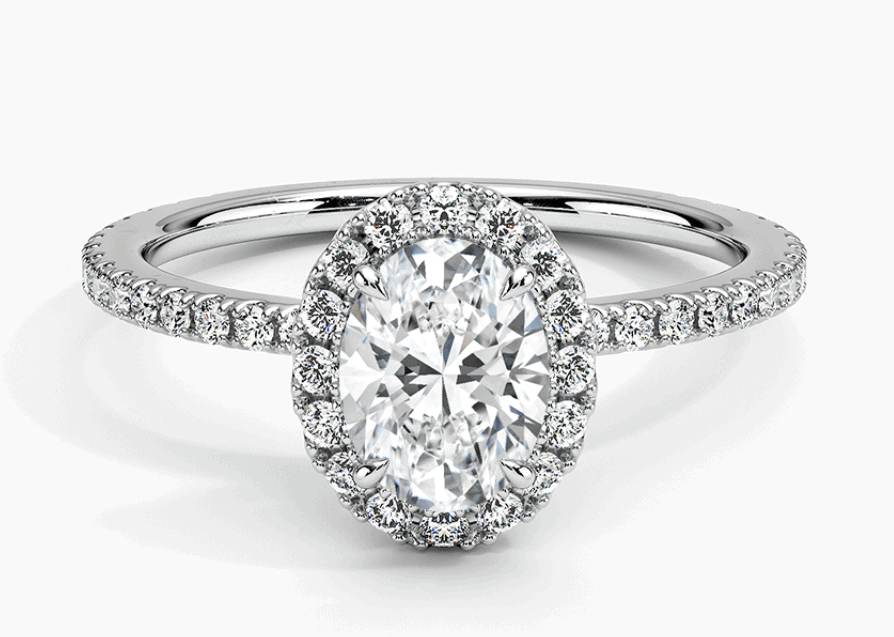
Looking for a more glamorous diamond engagement ring? The Waverly ring is sure to make an impression with an alluring halo style. Pavé diamonds adorn the band and encircle a center stone of your choice. Available in 18K gold or platinum.
Blue Nile Diamond Engagement Rings

Blue Nile, like Brilliant Earth, focuses on ethically sourced natural and lab-grown diamonds. Blue Nile’s diamond engagement rings lean a little more into the average, modern customer, with more affordable prices but still a commitment to standards above most diamond jewelers. With ample customer choice, from simple solitaire to side-stone and channel set, it’s a great place to shop online for a diamond engagement ring. There are many rings available in 14K gold, though they do carry a few 18K gold rings and platinum rings as well. They even carry a collection of Designer Engagement Rings.
Shop All Blue Nile Diamond Engagement Rings Here.
Design Your Diamond Engagement Ring
Start with a diamond or a setting and craft an engagement ring that fits your budget and style preferences. You can also shop by style– from solitaire to halo to side stone, unique, designer, and more. You’ll find diamonds up to 8.45 carats in about every cut you’d want. The process works as it did with Brilliant Earth, with excellent filters to sort by color, carat, shape, color, clarity, cut, and price. Ring settings are available in platinum and 14K gold and a few in 18K gold. You can also view rings with 3D technology and filter by rings that are ready to ship now if you’re in a hurry. Start Designing Here.
Zac Posen Knife-Edge Solitaire Engagement Ring
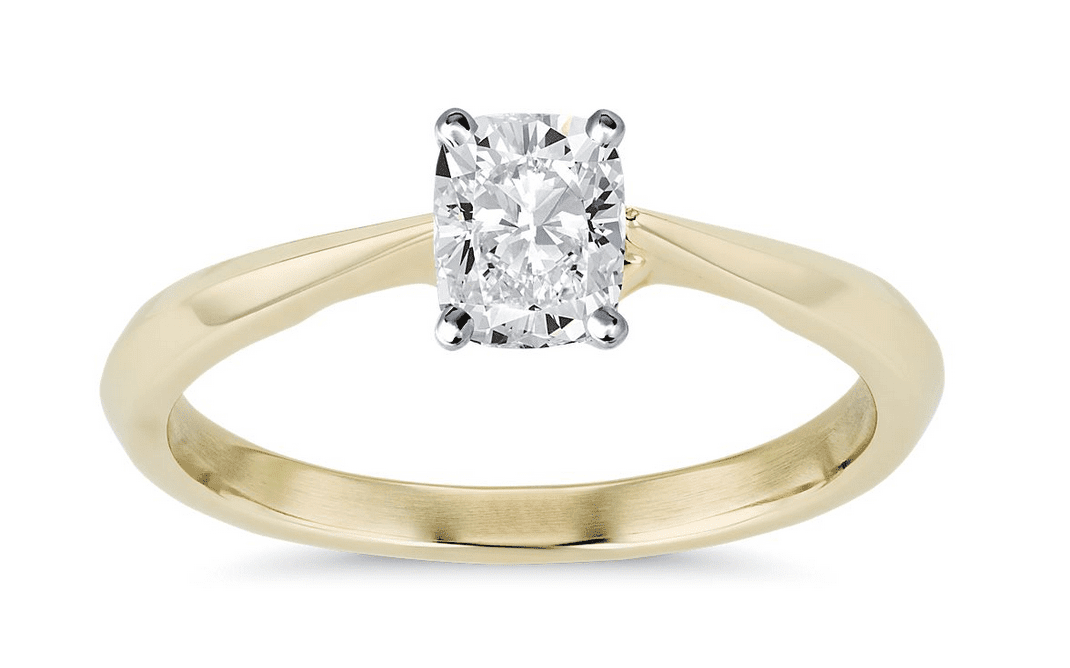
Love the solitaire setting but looking for a modern twist? This designer diamond engagement ring may be for you. A knife-edge shank pairs with a clean, modern band in your choice of platinum or 14K yellow gold.
Blue Nile Studio Heiress Halo Diamond Engagement Ring

Get ready to make an impression with this diamond engagement ring. A pavé-set diamond halo is always classic, and this one is glamorous as it is timeless. Crafted in your choice of 18K rose gold, 18K yellow gold, or platinum.
Zac Posen East-West Solitaire Engagement Ring

An elegant and sophisticated play on the solitaire design. This designer diamond engagement ring features an east-to-west curved band crafted in stunning platinum.
Where do I buy the best gemstone engagement rings?
Looking for a diamond engagement ring alternative? Sapphires, rubies, and moissanite are all excellent choices. Showcase a unique look and select a ring that expresses your love differently. Of course, just as is the case with diamond rings, you’ll need to be selective. You can find some gemstone rings at Blue Nile and Brilliant Earth as well, but I wanted to add two more options.
My Selection Criteria
For these two recommendations, I focused on two businesses that specialize in either gemstones or moissanite. Both have A+ ratings with the Better Business Bureau and have a gorgeous selection of rings. 14K and 18K gold and platinum bands are options, and styles range from classic to modern. All of these rings are not unique but crafted with beauty, with popular styles amongst customers.
Charles and Colvard Moissanite Engagement Rings
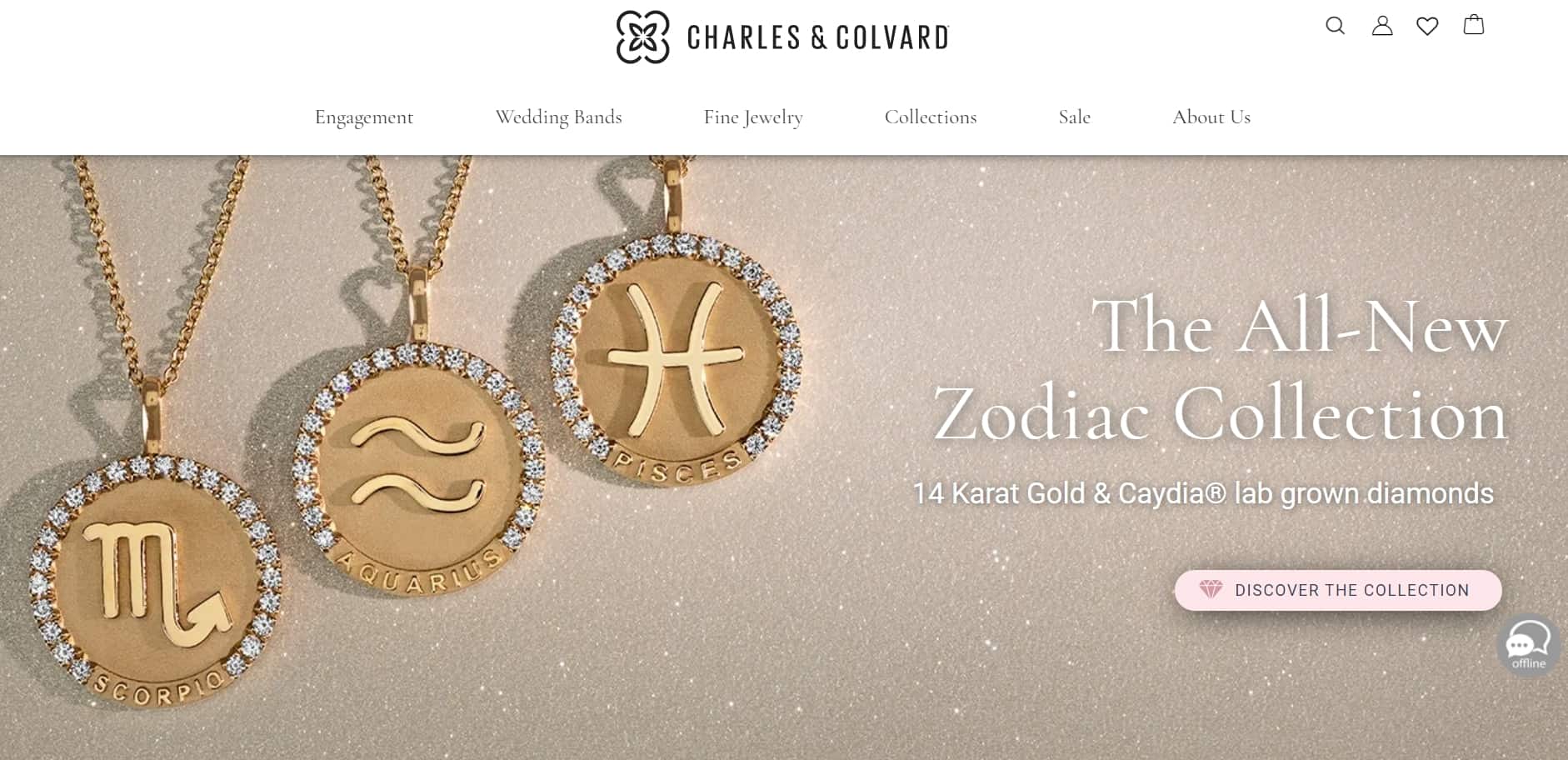
Charles and Colvard is the leader in moissanite– specifically Forever One moissanite. The highest-quality moissanite on the market is colorless and high in clarity. The sparkle from these rings is unparalleled. Charles and Colvard also have a history of excellent customer service, not to mention alluring modern and classic designs. You’ll have over 2,000 styles to choose from– plenty to find something that fits your style. Metal types include platinum, 14K white, yellow, or rose gold, and 18K white gold.
Collections include round brilliant, Old European, princess, step, modified brilliant, and duet rose. There are as many shapes as you’d find elsewhere, and you can sort by cut, price, metal type, and more. All pricing and grading are transparent. Shop All Charles & Colvard Moissanite Engagement Rings Here.
1.82 CTW Round Forever One Moissanite Solitaire with Side Accents Engagement Ring in 14K White Gold
This ring is a bestseller for a good reason. This solitaire ring is crafted in durable 14K wide gold and given an upgrade with side accent stones around the band. A round-cut center stone sparkles with timeless beauty.
2.70 CTW Round Forever One Moissanite Solitaire Engagement Ring

Beautiful and clean. This solitaire moissanite engagement ring impresses with its elegant simplicity. A classic four-prong setting highlights the sparkling center stone, with a 14K yellow gold sleek band.
2.25 CTW DEW Round Forever One Moissanite Signature Halo Engagement Ring
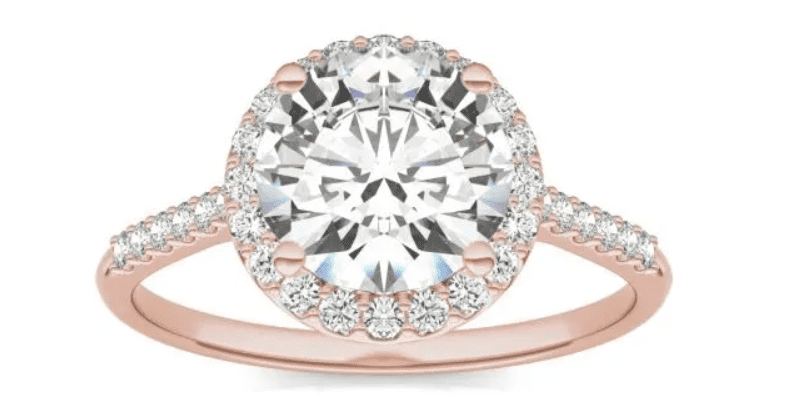
It’s tricky to find a rose gold engagement ring, but if you’re looking, this enchanting style may just be the right pick. Side accent stones and a halo around a round center sparkling moissanite. Brilliance radiates from every angle. The 14K rose gold band is romantic and unexpected.
Angara Gemstone Engagement Rings

Gemstone Rings can be a beautiful alternative to a diamond engagement ring. I recommend sticking with rubies or sapphires– a few may be careful enough to wear an emerald engagement ring. Many other colored gemstones are simply not durable enough for everyday wear. Still, there are many gorgeous options from Angara. Angara is known for its excellence in both diamonds and gemstones.
With an impressive collection of naturally sourced and lab-grown stones, Angara allows you to select from good to heirloom quality, all with official GIA ratings are stunning craftsmanship. Rings are available in 14K yellow, rose, or white gold, as well as platinum. I love that they carry modern, classic, and vintage-inspired designs. Shop All Angara Gemstone Engagement Rings Here.
Princess Diana Inspired Blue Sapphire Ring with Diamond Halo
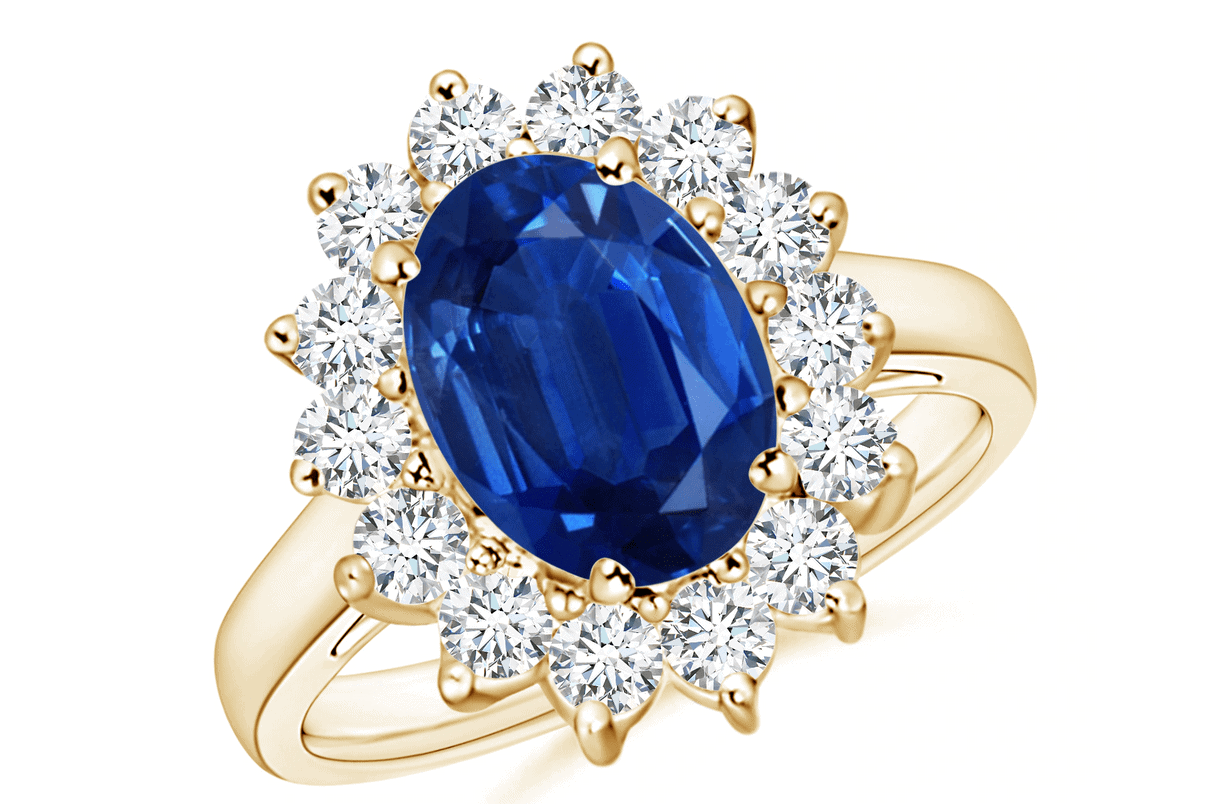
The name says it all. Modeled after Princess Diana’s iconic ring, this blue sapphire halo ring is one of my favorite engagement rings on the market right now. Round cut diamonds accent a floral halo around a center blue sapphire. Available in 14K yellow, rose, or white gold, as well as platinum.
Nature Inspired Ruby Crossover Ring with Leaf Motifs
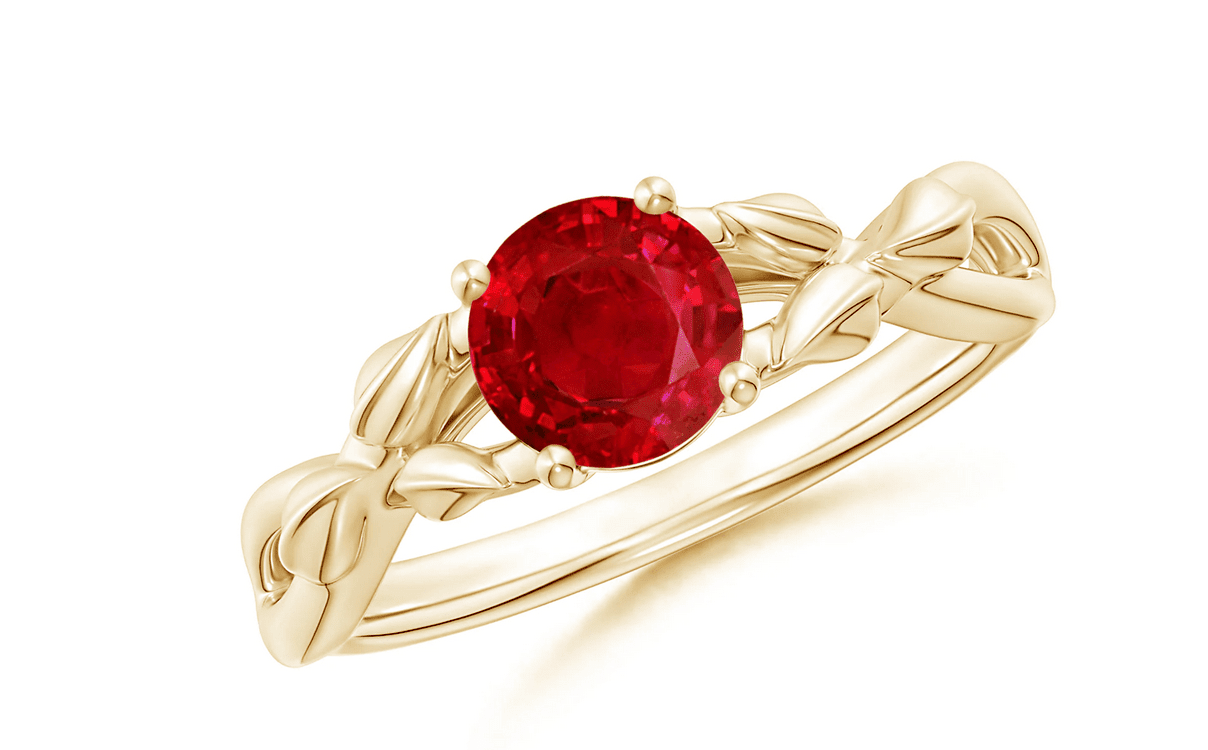
This nature-inspired ring is gorgeous and dainty. Intricate detailing on the shank accompanies a four-prong setting. The round ruby is sure to catch eyes. Available in 14K yellow gold, rose gold, yellow gold, and platinum.
Round Emerald Halo Ring with Diamond Accents
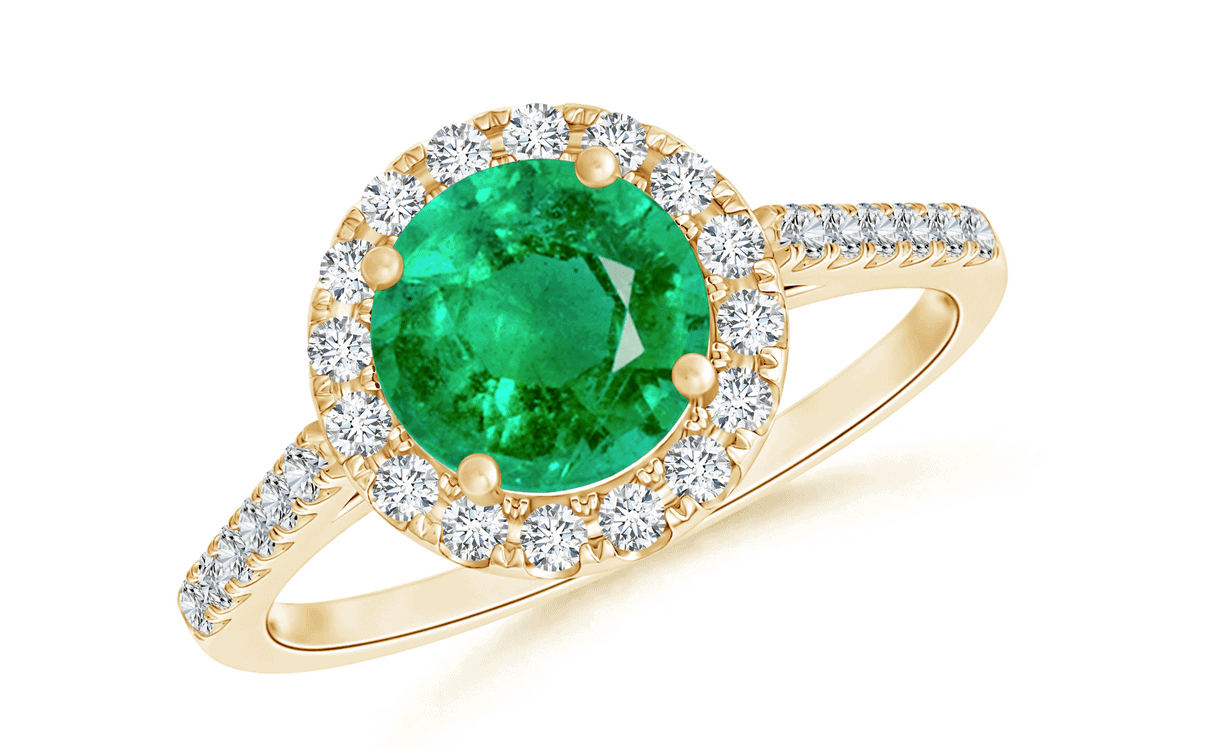
If it’s an emerald ring you’re looking for, this style is stunning. A breathtaking halo and band of accent diamonds sparkle around a round, center emerald stone. Available in your choice of 14K rose, yellow or white gold, or platinum.
Frequently Asked Questions
Question: Is it Bad Luck to Wear Your Engagement Ring on your Wedding Day?
Answer: It’s not bad luck to wear your engagement ring on your wedding day, but a common practice. Most brides swap their engagement rings onto their right hand before their ceremony. Thus, the engagement ring stays on the right hand, and the wedding ring is placed on the left.
Question: How Long After Engagement Should you Marry?
Answer: As is the case with nearly everything involved with wedding planning, there isn’t a set time you should get married after an engagement. Some are engaged for as little as a few months, while others are engaged for several years. But if you want an average-sized wedding and an average planning experience, I recommend giving yourself at least a year to plan. Keep in mind that you should order your wedding dress nine months in advance.
Question: Is Moissanite Better Than Cubic Zirconia?
Answer: Moissanite and cubic zirconia are both commonly used as diamond alternatives, but one is superior. Moissanite is more durable, more valuable, and closer in appearance to a diamond than cubic zirconia. Of course, moissanite does not look exactly like a diamond, and the difference is more noticeable the greater the carat.
Final Thoughts
The perfect engagement ring doesn’t exist. That’s one takeaway that many may not like– but it’s a positive thing. The amount you spend and the exact style you select isn’t the most important thing. What’s most important is that you select an engagement ring thoughtfully and what’s right for you and your partner. Set a budget, select between a diamond or alternative, then prioritize color and clarity. Carat size should be your last consideration. Keep in mind that a large carat ring is not always the best one.
Final Buying Recommendation
Looking for a diamond engagement ring that you can shop in-store for? Ritani offers a classic diamond engagement ring shopping experience (as well as online). You’re likely to get a great deal with policies such as price matching, diamond upgrades, and lifetime warranties. They carry both natural and lab-grown diamonds. Shop All Ritani Diamond Engagement Rings Here.
Further readings:
How to Find the Best Wedding Bands


